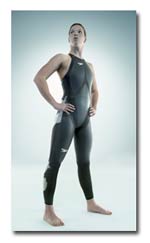 I think the definition of fabric is evolving so fast these days that it it has become just as archaic and just as absurd a concept as using the word "horsepower" to describe how powerful a formula-one engine is. (I am using a little Carl Sagan here in my analogy.)
I think the definition of fabric is evolving so fast these days that it it has become just as archaic and just as absurd a concept as using the word "horsepower" to describe how powerful a formula-one engine is. (I am using a little Carl Sagan here in my analogy.)Nonetheless, imagine a team of 1,250 horses lined up by twos pulling a stage coach as fast as they could? I think the Formula-one car would win. Consequently, see how inaccurate the term horsepower has become?
Read this snippet from Textile World describing the material of the Speedo LZR: "...Mectex applied an exclusive water-repellent and other treatments using its newly developed Plasmaterial™ technology, an eco-friendly nanotechnology using the energy of cold plasma and no chemicals or water to permanently modify the fabric surface. Isaac said the treatments reduce water absorption to only 2 percent of fabric weight, as opposed to 50 percent absorption in the Fastskin fabric. ..." [Link]
That is not a fabric, that is a woven, solidified, chemical of some kind. There is nothing really organic here or am I wrong? I am guessing that the suit started out as a fabric and then is altered by having the threads merge during this plasma process.

2 comments:
Tony, thanks for reading Textile World! I would, however, have to disagree. The fabric, as stated in Janet’s article, is a tightly woven 2-way stretch fabric. I found that unusual, because knit structures are much more common in swimwear. There is no doubt this is a highly engineered system. The fact that it is a woven seems to let the garment designer control where and in what directions the stretch is applied there by compressing certain parts of the swimmer’s anatomy. Plasma doesn’t melt or merge anything; it changes the surface properties of the fabric, in this case making the fabric more water-repellent. Plasma is thought to be a more eco-friendly way of treating the fabric because a more traditional method would use water-repellent chemicals, like Scotchgaurd or Teflon, that are applied to the fabric for a similar result. The plasma treatment is dry, no chemicals, no effluent, etc. I can see why your sport may be concerned about the leap these garments take. Competitive swimmers have gone from wearing high-coverage wool or cotton garments to wearing as little as possible, and now to wearing highly engineered garments that cover the majority of the swimmer’s body. With the way technology is changing, I am sure the next generation of garments will make you questions things further. But that is just the beginning. There are technologies at the fiber level, not used in this garment, like Holofiber from Hologenix LLC, that are said to raise the oxygen level in the wearer’s blood, this can help in training and in recovery after training or competing. It also is said to help with jet lag or help people with circulation problems.
Wow! What a primer that was! That showed me! I am going to make your comment into a post!
Post a Comment